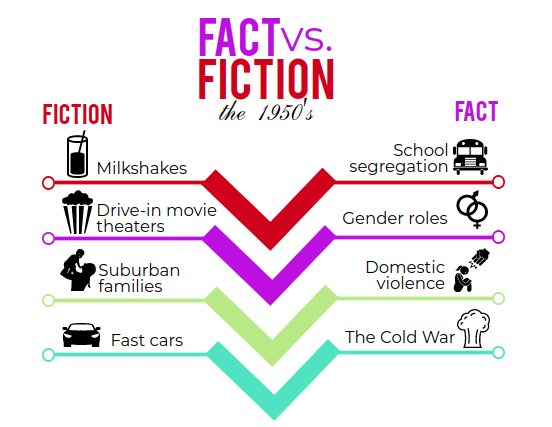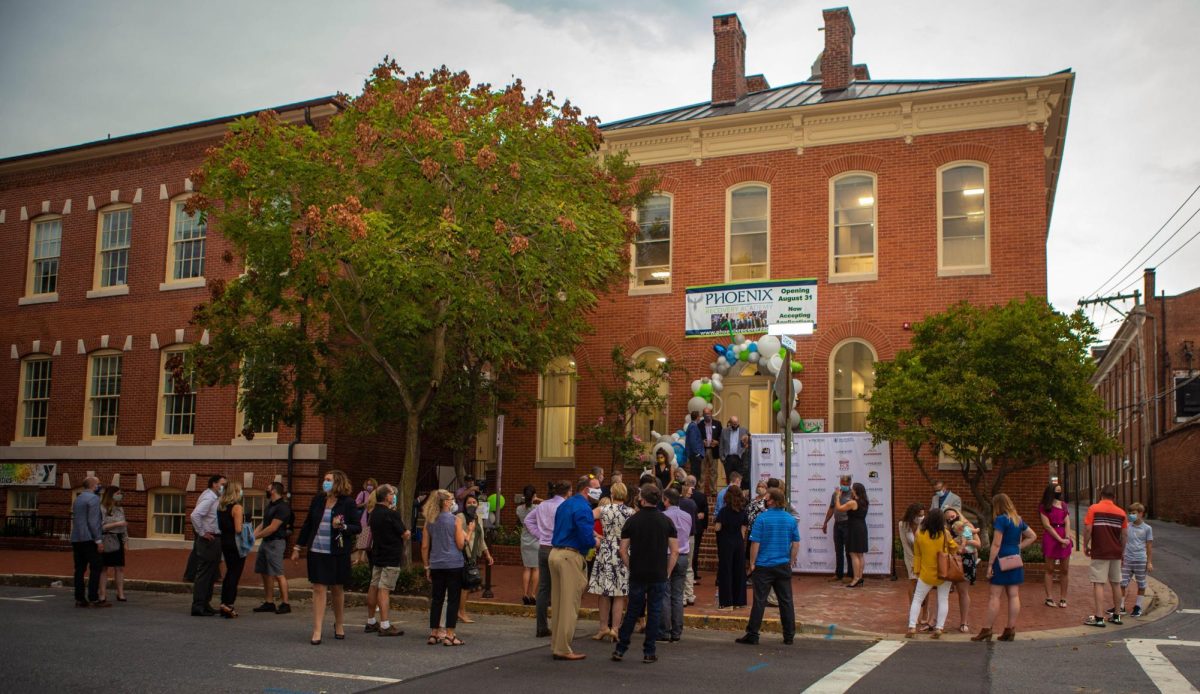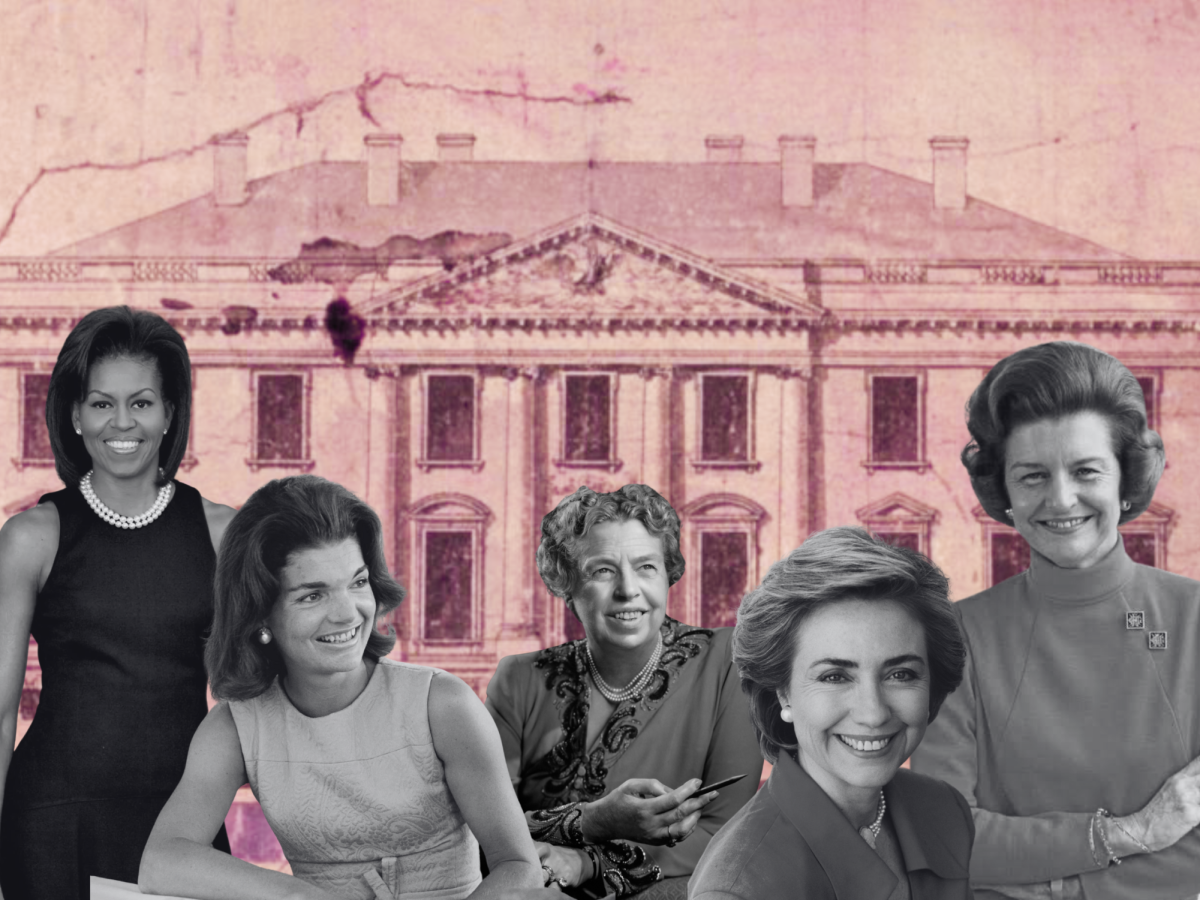Happy Days? For some, I suppose.

Graphic by Charlotte Alden.
January 22, 2018
For many, the 1950s have an idyllic luster. A Google search of the decade produces images of milkshakes, drive-in movie theaters and Elvis Presley. From those images alone, it’s difficult to perceive that beneath its gilded sheen, the 1950s produced the beginnings of the Cold War, mounting racial tensions and post-war gender roles.
Despite the facade, a a closer examination of classic 1950s photos reveals one telling sign that the Fabulous 50’s were anything but: in these images of carefree recreation, every American is white.
As a Twitter-infested “Year from Hell” came to a close—and with 2018 likely to be just as fake news-worthy as the last—many Americans are eager to look to the past for solace in this tumultuous time.
To commemorate the good old days, today’s movies promote a starry-eyed 1950s nostalgia, portraying this turbulent decade through rose-colored glasses rather than depicting the sobering reality that the Fabulous 50s were merely a dream for some. In fact, this isn’t just an issue unique to the ʼ50s. Popular depictions of American culture, from the Roaring Twenties to the Grunge years of the ʼ90s, often exclude these eras’ unpleasant realities.
But romanticizing history in film and media isn’t just an issue of inaccuracy; it threatens to erase the struggles of women and minorities entirely from the big screen, and, more importantly, from the consciousness of many Americans.
Glamorizing the Baby Boom era isn’t new. In 1974, America tuned into the TV show Happy Days and met Richie Cunningham and Arthur Fonzarelli. Only a few decades post-WWII, America was in the midst of a war in Vietnam, an unprecedented political scandal and a counterculture movement. Longing for a happier time, millions of Americans watched Richie and Fonz jitterbug, bop, and of course, sip milkshakes in post-war suburbia.
Four years later, Americans would tap their feet to the Grease soundtrack as Danny Zuko and Sandy Olsson sang about fast cars, drive-in movies and Rock n’ Roll. In 2016, Fox aired the TV musical Grease: Live!, bringing the network its best ratings of the 2015-16 television season.
But despite portrayals in movies and TV, women and minorities in the 1950s saw the entrenchment of traditional gender roles, the rise to prominence of the KKK and persistent school segregation—trends largely excluded from these retro recreations.
Hollywood renditions of suburbia portray a well-mannered 1950s man. In fact, a 2012 Scaramouche & Fandango study revealed that 61 percent of women prefer the “manly men” of the ʼ50s to today’s men. But 1950s ads reveal the true nature of the relationship between guys and dolls: a menswear ad depicts a woman, hair curled and makeup applied, serving her husband breakfast in bed and reads, “Show Her It’s a Man’s World.” In a 1952 “educational booklet,” Co-Le Sales Company instructs men why they should beat their wives.
For African-American men and women, life in the 1950s was even more unbearable.
African Americans were excluded from popular culture in 1950s television shows, and continue to face underrepresentation in modern-day media. Some African-Americans today report wondering why Happy Days producers excluded the segregated housing just miles from the Cunningham’s Milwaukee suburban home and a century of documented lynchings in Wisconsin, reports the Washington Post.
Accurately depicting the 1950s is necessary to awaken Americans who choose to ignore post-war racism and sexism. Truthfully depicting the Civil Rights Movement to students early on makes them more likely to share what they’ve learned with their parents, promoting dialogue about race and potentially reducing long-held biases, reports The Guardian. Portraying the challenges minorities and women faced in the 1950s will allow us to address present-day inequality and create further discourse.
Of course, the 1950s weren’t all bad. In Brown v. Board, the Supreme Court ruled that “separate educational facilities are inherently unequal;” Betty Friedan heralded a new wave of feminism in publishing the Feminine Mystique; and medical and scientific discoveries grew at an exponential rate.
But we can’t allow the eras’ achievements—or milkshakes, for that matter—let us forget that pop culture overwhelmingly ignores a defining aspect of the 1950s: inequality. Until then, it’s time we recognize that for some, the Happy Days weren’t so happy after all.










